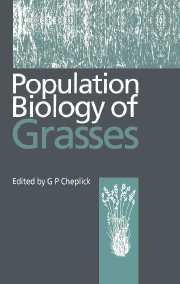Book contents
- Frontmatter
- Contents
- Contributors
- Preface
- Darwin revisited: approaches to the ecological study of grasses
- Part one Population variation and life history patterns
- 1 Allozyme diversity in the grasses
- 2 Ecology of seed dormancy and germination in grasses
- 3 Seed dispersal and seedling establishment in grass populations
- 4 Clonal biology of caespitose grasses
- 5 Ecological aspects of sex expression in grasses
- 6 Interspecific variation in plasticity of grasses in response to nitrogen supply
- 7 Population biology of intraspecific polyploidy in grasses
- Part two Ecological interactions
- Part three Population biology of specific groups
- Index
2 - Ecology of seed dormancy and germination in grasses
Published online by Cambridge University Press: 14 September 2009
- Frontmatter
- Contents
- Contributors
- Preface
- Darwin revisited: approaches to the ecological study of grasses
- Part one Population variation and life history patterns
- 1 Allozyme diversity in the grasses
- 2 Ecology of seed dormancy and germination in grasses
- 3 Seed dispersal and seedling establishment in grass populations
- 4 Clonal biology of caespitose grasses
- 5 Ecological aspects of sex expression in grasses
- 6 Interspecific variation in plasticity of grasses in response to nitrogen supply
- 7 Population biology of intraspecific polyploidy in grasses
- Part two Ecological interactions
- Part three Population biology of specific groups
- Index
Summary
Introduction
The caryopsis (hereafter called seed) germination stage of the life cycle of grasses is of much interest to (1) agriculturalists establishing fields of cereals to be harvested for grain, (2) range and grassland managers revegetating overgrazed or otherwise disturbed lands, (3) weed specialists attempting to control weeds in crops, pastures, lawns, and even in natural plant communities and (4) ecologists investigating plant life histories and the dynamics of plant populations, communities and ecosystems. Through experience, agriculturalists, land managers, weed biologists and ecologists have come to realize that the seeds of many grasses are difficult to germinate; consequently, much research has been done on their dormancy and germination. In fact, Simpson (1990) published a book entitled Seed Dormancy in Grasses. However, this wonderful compendium of information was written from a physiological point of view and, therefore, does not devote much attention to the ecological perspective of seed germination.
The importance of knowing about the germination ecology of grasses is illustrated by the fact that in moist temperate regions, where precipitation is not a limiting factor per se, seeds of grasses germinate in (1) autumn, (2) spring, (3) autumn and spring, (4) summer, (5) spring, summer and autumn or (6) spring and summer, depending on the species (Brenchley & Warington, 1930; Roberts & Ricketts, 1979; Roberts & Potter, 1980). Further, in seasonally wet regions grasses have distinct germination phenology patterns (Mott, 1972, 1978; Silva & Ataroff, 1985; Evans, Kay & Young, 1975).
- Type
- Chapter
- Information
- Population Biology of Grasses , pp. 30 - 83Publisher: Cambridge University PressPrint publication year: 1998
- 200
- Cited by

